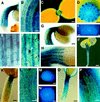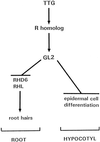A common position-dependent mechanism controls cell-type patterning and GLABRA2 regulation in the root and hypocotyl epidermis of Arabidopsis
- PMID: 9576776
- PMCID: PMC35023
- DOI: 10.1104/pp.117.1.73
A common position-dependent mechanism controls cell-type patterning and GLABRA2 regulation in the root and hypocotyl epidermis of Arabidopsis
Abstract
A position-dependent pattern of epidermal cell types is produced during root development in Arabidopsis thaliana. This pattern is reflected in the expression pattern of GLABRA2 (GL2), a homeobox gene that regulates cell differentiation in the root epidermis. GL2 promoter::GUS fusions were used to show that the TTG gene, a regulator of root epidermis development, is necessary for maximal GL2 activity but is not required for the pattern of GL2 expression. Furthermore, GL2-promoter activity is influenced by expression of the myc-like maize R gene (35S::R) in Arabidopsis but is not affected by gl2 mutations. A position-dependent pattern of cell differentiation and GL2-promoter activity was also discovered in the hypocotyl epidermis that was analogous to the pattern in the root. Non-GL2-expressing cell files in the hypocotyl epidermis located outside anticlinal cortical cell walls exhibit reduced cell length and form stomata. Like the root, the hypocotyl GL2 activity was shown to be influenced by ttg and 35S::R but not by gl2. The parallel pattern of cell differentiation in the root and hypocotyl indicates that TTG and GL2 participate in a common position-dependent mechanism to control cell-type patterning throughout the apical-basal axis of the Arabidopsis seedling.
Figures




Similar articles
-
Embryonic control of epidermal cell patterning in the root and hypocotyl of Arabidopsis.Development. 2001 Oct;128(19):3697-705. doi: 10.1242/dev.128.19.3697. Development. 2001. PMID: 11585796
-
Epidermal patterning genes are active during embryogenesis in Arabidopsis.Development. 2003 Jul;130(13):2893-901. doi: 10.1242/dev.00493. Development. 2003. PMID: 12756173
-
The homeobox gene GLABRA2 is required for position-dependent cell differentiation in the root epidermis of Arabidopsis thaliana.Development. 1996 Apr;122(4):1253-60. doi: 10.1242/dev.122.4.1253. Development. 1996. PMID: 8620852
-
Pathways for epidermal cell differentiation via the homeobox gene GLABRA2: update on the roles of the classic regulator.J Integr Plant Biol. 2012 Oct;54(10):729-37. doi: 10.1111/j.1744-7909.2012.01159.x. J Integr Plant Biol. 2012. PMID: 22943441 Review.
-
Cell fate in plants. Lessons from the Arabidopsis root.Symp Soc Exp Biol. 1998;51:11-7. Symp Soc Exp Biol. 1998. PMID: 10645418 Review.
Cited by
-
TRANSPARENT TESTA GLABRA1 and GLABRA1 Compete for Binding to GLABRA3 in Arabidopsis.Plant Physiol. 2015 Jun;168(2):584-97. doi: 10.1104/pp.15.00328. Epub 2015 Apr 29. Plant Physiol. 2015. PMID: 25926482 Free PMC article.
-
What causes opposing actions of brassinosteroids on stomatal development?Plant Physiol. 2013 May;162(1):3-8. doi: 10.1104/pp.112.213058. Epub 2013 Mar 12. Plant Physiol. 2013. PMID: 23482875 Free PMC article.
-
A versatile and reliable two-component system for tissue-specific gene induction in Arabidopsis.Plant Physiol. 2006 Aug;141(4):1194-204. doi: 10.1104/pp.106.081299. Plant Physiol. 2006. PMID: 16896232 Free PMC article.
-
CAPRICE positively regulates stomatal formation in the Arabidopsis hypocotyl.Plant Signal Behav. 2008 Dec;3(12):1077-82. doi: 10.4161/psb.3.12.6254. Plant Signal Behav. 2008. PMID: 19513241 Free PMC article.
-
GLABRA2 Directly Suppresses Basic Helix-Loop-Helix Transcription Factor Genes with Diverse Functions in Root Hair Development.Plant Cell. 2015 Oct;27(10):2894-906. doi: 10.1105/tpc.15.00607. Epub 2015 Oct 20. Plant Cell. 2015. PMID: 26486447 Free PMC article.
References
-
- Avers CJ. Fine structure of phleum root meristem cells. II. Mitotic asymmetry and cellular differentiation. Am J Bot. 1963;50:140–148.
-
- Berger F, Hung C-Y, Dolan L, Schiefelbein J (1998) Control of epidermal cell division in the root meristem of Arabidopsis thaliana. Dev Biol (in press) - PubMed
-
- Bunning E. Uber die Differenzierungsvorgange in der Cruciferenwurzel. Planta. 1951;39:126–153.
-
- Cormack RGH. The development of root hairs in angiosperms. Bot Rev. 1949;15:583–612.
-
- Cutter EG (1978) Plant Anatomy. Clowes & Sons, London, pp 94–106
Publication types
MeSH terms
Substances
LinkOut - more resources
Full Text Sources
Other Literature Sources
Molecular Biology Databases
Research Materials

